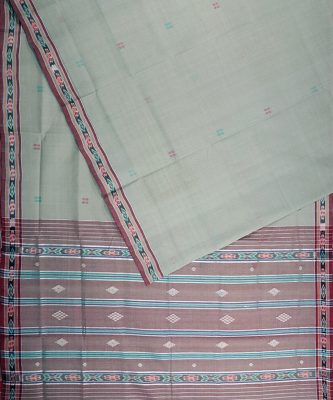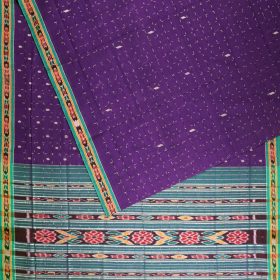GI Tag
Sambalpuri Bandha Saree and Fabrics
The Sambalpuri Ikat is also known as Sambalpuri bandha which refers to the tie and dye method of double ikat weaving weavers follow to create it. Drawing its inspiration from conch shells, creeper, fish and temples, Sambalpuri Ikat is curvilinear and feathery as compared to other ikat styles. Believed to have migrated to the Western region of Odisha in 12th Century AD from northern India, the Bhulia community is the torchbearer of the ‘Bandha Kala’ that flourishes in Sambalpur and Bargarh. The threads forming the design are repeatedly tied and dyed in different colours and the simple interlacement of the threads materializes the design. The patterns of Sambalpuri bandha brings extraordinary craftsmanship into motifs from ordinary life.
Bomkai
Signified by intricate thread work woven beautifully on a handloom, the bomkai sarees are weaves that bear stories depicted in sophisticated motifs. Traditions, livelihood, mythology can all be seen in this exquisite weave. Woven on a pit loom, Bomkai, which is also known as Sonepuri, is an extraordinary fabric that results from the confluence of two extremely popular components of the Orissa textile industry. In its simplest, Bomkai can be explained as an extra weft technique on a pit loom.It is an outcome of Ikat and embroidery interwoven into each other . Originating from a quiet village of Bomkai, Ganjam, the technique uses motifs ofKanthiphula, Atasi flower, birds, peacock, rudrakshaand many more. Woven only on one side, Bomkai is an immensely complex art of weaving, indigenous and prized by the people of Odisha as a craft.
Khandua
Khandua Patta is a style of Odisha Ikat weave also known as Maniabandhi and Kataki.Handwoven by weaver communities of Maniabandha, the Khandua is mostly created on bright colour fabrics with auspicious motifs inspired from temples of Odisha, peacocks, mythical elephants (Nabakunjara) and flower vines. Apart from the traditional khandua worn by women during wedding rituals and pious days, the kenduli Khandua or the Gita govinda Khandua with words of Gita Govinda etched on its folds, is worn by Lord Jagannath on many occasions.Devadasis and Odissi dancers wear Khandua during dance recitals.This ritualistic and cultural significance makes Khanduapatta a treasured fabric by the Odia people.
Gopalpur Tussar fabric
Indigenous to Gopalpur village, Jajpur, Gopalpur Tussar is a silk fabric woven by hand known for its finesse and smoothness. Embellishments are done by hand, either with extra weft or extra warp with a’bandha’ pattern in hand; the embellishments increase the value of the fabric. Traditionally, thread is wound around the chadaki to fill the bobins for weft with the help of a spinning wheel.Fabric is woven using a’cut shuttle technique’, in which shuttles interlock with one another to form foda kumbha in the weft direction. By tie and die bandha technique, the foda kumbha pattern is copied for multiple productions. Threads are dyed in different shades, such as maroon, red and rust. Fabrics are enhanced with a weft and cut shuttle technique. Made from absolute natural silk Gopalpur Tussar fabrics are a sign of luxury and class. Worn earlier by upper class Odia as dhoti and saree, Gopalpur Tussar is now available for the masses.
Kotpad
Kotpad cottons are woven in the tribal regions of southern Odisha by the Mirgan community. In the Kotpad area, weavers use the name Panika. Inherently rough to the touch, this pit-loom spun 100% organic cotton fabric is naturally dyed with the roots of the Aal or Indian Madder tree. Kotpad dyeing is an entirely organic, manual, labor-intensive and long-drawn-out process done mostly by the women of the community. These fabrics do not contain any chemicals & are a stunning amalgamation of nature’s gifts & human ingenuity. Close to a month of labor results in the cotton threads’ metamorphosis from the original cream shade to dramatic reds, maroons, rusty pinks, coffee browns and deep blacks. The dyed threads are then handed over to Kotpad’s famed weavers. Working on pit looms, they turn these into elegant saris, shawls and stoles with delicate motifs of significance to the tribal life.
The relative isolation of the tribal communities has kept the craft of textile dyeing and weaving in Kotpad true to its traditional moorings. Yet, its simplicity and sophistication are what have drawn the attention of urban people to this humble but rare fabric.
Habaspuri
Woven by the tribal kondh weavers of Chincheguda, Kalahandi, Habaspuri is an age old tribal life inspired weaving style on naturally dyed cotton. The weavers of Junagarh district produce Habaspuri fabrics exotically decorated with fish, flower and danti motifs by using Jalla technique on fly shuttle pit looms. The anchal is multi colour with tribal motifs while the border is inspired from temples.
Berhampur Silk Patta
Woven on fine silk, the Phodakumbha pattern of saree weave dates back to the Era of Mohuri kings in 14th century Berhampur. Cretaed from the expertise of Dera weavers, the BerhampuriPatta is also regarded as the Lord’s fabric because it is favoured by Jagannath on many pious occasions. The phodakumbha imitates the shape of the symmetrical temple spire of Utkalian temples. The border and motifs are often woven with threadsof gold and include zari work that is a sign of opulence and prosperity for many newly married couples.
The Patta Joda is a long cloth worn by the men on ceremonial occasions like weddings and puja. In ancient times, it was only worn by kings and gods, but with modern progress and commercialization, it is now accessible to everyone.
Dhalapathar Parda and Fabrics
The Dhalapathar Parda is a style of curtain weaving that originated in the village of Dhalapathar, Odisha. Woven by a community of weavers called “ Rangani” , the parda is woven from thick threads of pure cotton by a special weaving technique that recreates temple like designs and motifs on the curtain. The pardas are handmade and dyed from extracts of fruits, trees and mud. The curtains render a pious ambience to your home when the motifs of temple architecture are recreated at the entrance.
The Dhalapathar Saree of KusumKapta, Nahati and Akata aresmooth textured premium cotton sarees with similar inspirations as the Parda and are often worn as wedding saree in many regions of Odisha. Such is the finesse of Dhalapathar weavers that even the recreation of Taj mahal was not impossible for the two famous rangani weavers, Late Udaynath Sahoo and Harekrushna Rout.
















